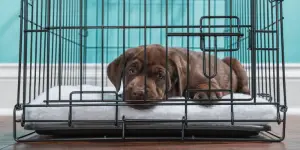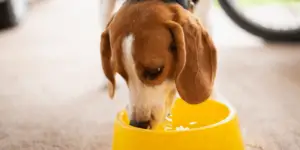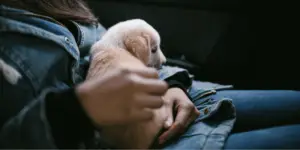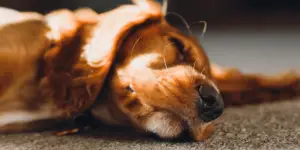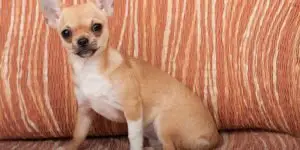
Puppy Teething - Everything You Need to Know
- Written by Joshua Gordon
- Last updated
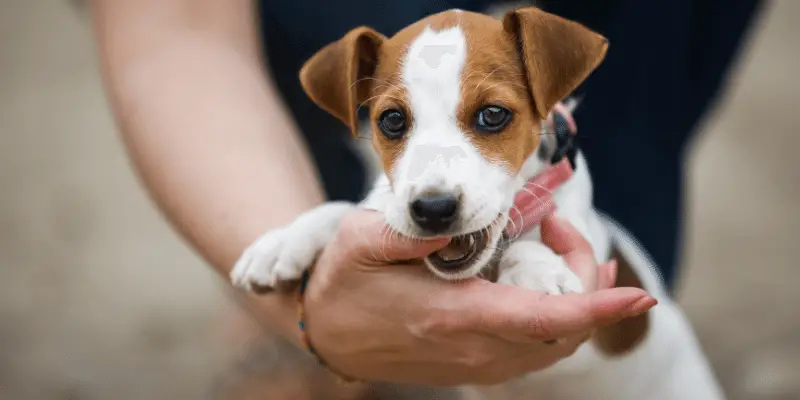
Puppy Teething – What to expect
A teething puppy can be frustrating to deal with. When they’re not using your hands as chew toys, they’re gnawing everything else in sight, including those brand new shows you’d just bought.
Unfortunately, teething in puppies lasts several months, so it’s not something that simply goes away overnight. It’s often one of the most challenging parts of owning a puppy as you’ll need the eyes of a hawk to keep them out of mischief.
If you’re looking for ways to help manage a teething puppy, you’re in the right place. Here’s everything you need to know about puppy teething so you’ll know exactly what to do at each stage of your pup’s dental development.
In this article
What Is Puppy Teething?
Just like human babies and children, puppies go through teething as they grow and develop. Teething occurs when either your puppy’s deciduous (i.e., baby teeth) or adult teeth begin to erupt through their gums

When Do Puppies Start Teething?
Puppies are not born with any teeth, but by around 3 weeks of age, they will start teething. The incisors (located at the front of your pup’s mouth) and the canine teeth will come in first, followed by the premolars.
By about 6 weeks of age, all of your puppy’s deciduous teeth should have emerged. However, that’s not the last of your puppy teething worries. Your puppy will go through the process again when their adult teeth begin erupting

Ask the Vet - When will my puppy stop teething?
"For most dogs, they will have all of their adult teeth between the ages of 6 and 7 months. Teething tends to be at its worst between 3 and 5 months, when dogs will chew a lot and may have visibly red gums.
If your dog still has any deciduous (milk) teeth at 8 months old, let your vet know"
- Dr Linda Simon MVB MRCVS
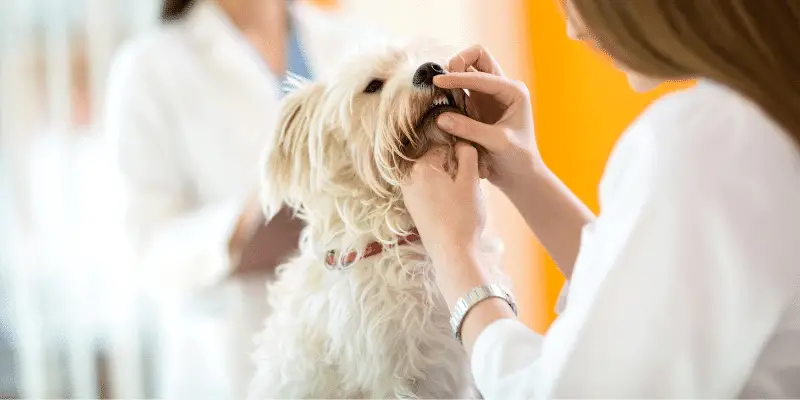
When Do Puppies Lose Their Teeth?
Your puppy’s deciduous teeth only stick around for a month or so once they have emerged. At approximately 12 weeks old, the baby teeth will begin to fall out to make room for permanent adult teeth.
Don’t be alarmed if you find teeth on the floor in your puppy’s bedding around this age. Your puppy may end up swallowing some of their teeth, which is harmless and not a cause for concern.
Puppies have 28 deciduous teeth, but once their secondary teeth have finished coming in, they will have 42 teeth.
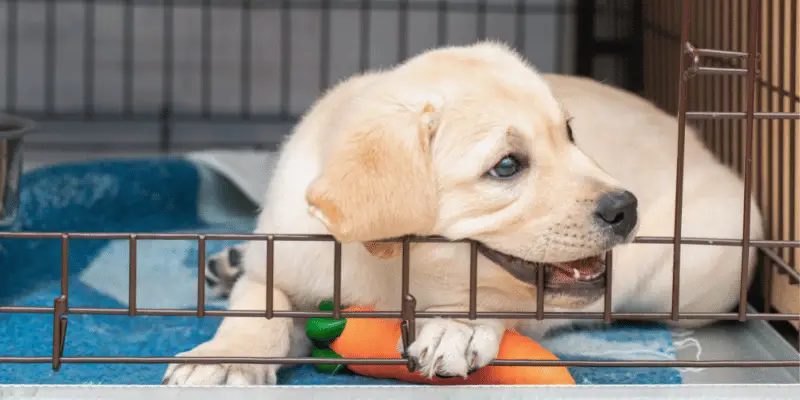
How to Help a Teething Puppy
While dealing with a teething puppy can be a bit of a pain, it’s a lot more painful for your pooch. As the teeth erupt, your puppy’s gums will be very sore and tender, which may make them whine or find inappropriate ways to relieve some of the discomfort, such as nipping.
Fortunately, there are a few things you can do to help your puppy through the teething process to make them feel a little better.
Chew toys are one of the best ways to combat teething in young dogs. They provide relief for your pup by giving them something to press their gums on. In addition, toys satisfy your pup’s desire to chew while also providing mental stimulation.
This helps keep them out of trouble and discourages gnawing on your furniture or belongings.
The type of chew toys you offer will differ depending on your dog’s size. Smaller breeds will need toys that are appropriate to their size so they’re able to hold them in their mouth.
Kong toys, especially if you freeze them beforehand (great for soothing sore gums), are excellent options for teething puppies, alongside teething rings, flavoured puppy chews, and rubber bones.
Remember to supervise your puppy at all times when they are playing with toys. If a toy becomes damaged or has large chunks/fibers falling off it, don’t let your puppy continue using it.
Another solution to help a teething puppy is to use dog-safe teething gels. These work similarly to teething gels made for toddlers. You smear a small amount of the gel around your puppy’s gums to ease the pain and inflammation.
Only use teething gels intended for puppies as other types can contain ingredients that are harmful or unhealthy.
Frozen carrots are also ideal for teething puppies. Not only are they fantastic (and healthy!) chew toys, but the cooling sensation will offer relief on your pup’s inflamed gums.
Although carrots are nutritious and provide vitamins and minerals, don’t offer them in large quantities (one carrot a day at most). Their high fiber content can cause digestive irritation and diarrhea in puppies.
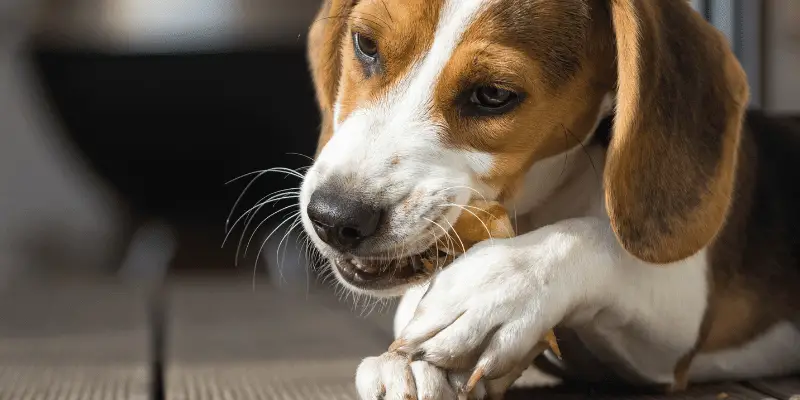
Puppy Teething Timeline
Weeks 2 to 4
At 2 to 4 weeks of age, puppies will start developing deciduous teeth. At this point, they are far too young to leave their mother and be adopted out.
Weeks 5 to 6
Between the ages of 5 and 6 weeks old, puppies will have most of their deciduous teeth. Once they hit around 6 weeks of age, all of their baby teeth should have finished erupting.
After puppies reach 8 weeks old, they are ready to leave their mother and go to their new homes.
Weeks 12 to 16
After 12 weeks of age, puppies will begin losing their deciduous teeth to make room for their permanent teeth. This is around the time you might find tiny teeth on your floor or around your puppy’s bedding.
6 Months and Older
By 6 months of age, puppies will usually have all of their permanent teeth. If you notice any deciduous teeth left in your pup’s mouth, speak to your vet as they may need removing.

Common Symptoms of Puppy Teething
Not sure if your puppy is teething? Here are some common symptoms that signal teething in young dogs.
Chewing on Everything
All dogs love to chew, but if you notice your puppy purposely trying to find objects around the house to gnaw on, it normally indicates teething.
It’s important to offer your puppy an assortment of chew toys and teach them that biting on anything else is inappropriate, including your hands. It might be cute when your puppy is small, but it won’t be when they’re a fully-grown adult with much bigger teeth.

Frequent Drooling
Some dog breeds are prone to drooling, such as Bulldogs and Bloodhounds, but excessive drooling is also a common sign of teething in puppies. As teeth push out of your puppy’s gums, it causes tenderness and soreness, which can result in an unusual amount of drool.
Slow to Eat
Teething is quite painful for puppies as their gums will be irritated and inflamed. This can make your pup a little slow to eat or cause them to lose their appetite altogether.
You can work around this by offering soft foods (speak to your vet beforehand for advice and suggestions) or by using a puppy-safe teething gel to provide some pain relief.

Bleeding, Red, or Swollen Gums
During teething, it’s normal for your puppy to have red, bleeding, or swollen gums. This is due to teeth erupting through the gums, resulting in irritation.
If your puppy has just lost one of their deciduous teeth, you might notice some blood, so try not to be alarmed. Bleeding may also occur while your puppy is eating or chewing.
That said, if you see a large amount of blood, check over your puppy’s mouth to make sure they haven’t hurt themselves. If you’re concerned, don’t hesitate to get your dog seen by a vet.
Whining a Lot
Puppies usually whine and cry a lot, especially when they are left alone or have just gone out to their new homes.
Whining is also a common symptom of teething puppies, so if your pup is crying while you’re around, they may have sensitive or painful gums.
Provided your pooch isn’t whining excessively, it’s not usually a cause for concern. As always, if you’re worried or think the crying is associated with an injury or illness, speak to your vet.
Visible Lost Teeth
One of the last common symptoms of puppy teething is visible lost teeth. If you look inside your puppy’s mouth, you might find indentations where their baby teeth used to be and spot permanent teeth emerging.
Most puppies swallow their baby teeth when they fall out, but sometimes you’ll find them on your floor or around your puppy’s bedding.

Teething Behaviour
In addition to symptoms of whining and drooling, there are a couple of behaviours you need to look out for during the teething process in puppies.
Puppy Biting
It’s not uncommon for puppies to bite and nip, especially when they are teething. Surprisingly, those tiny teeth are needle-sharp, so it can be quite painful if they latch onto your skin.
You should discourage nipping and biting early on as you don’t want your puppy to think it’s appropriate to chew on you or other people (more on this later!).
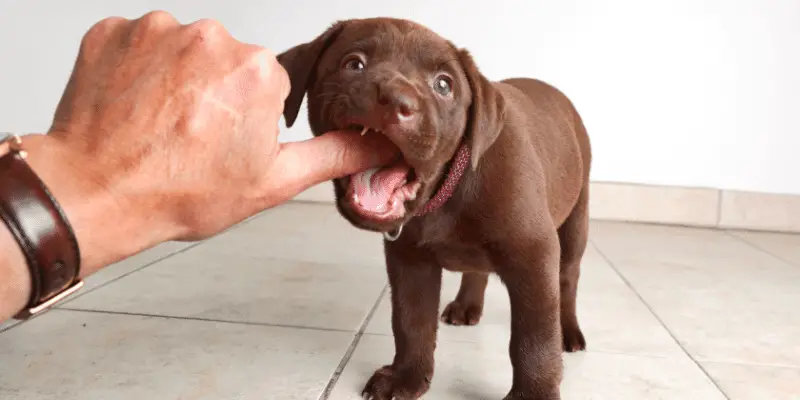
Chewing
Chewing is in every dog’s instinct, especially in puppies as it relieves pain from sore gums. Pups also chew to explore the world and to control their bite strength.
Although it’s completely normal for young and older dogs to chew, it’s important you teach puppies not to gnaw on inappropriate objects and items. Toys, and plenty of them, should be provided to your puppy during teething.
They provide enrichment and keep your puppy occupied when you’re busy or not around to play with them. Furthermore, they discourage your puppy from nibbling on your furniture and belongings.
What Are the Best Chew Toys?
Durable and heavy-duty chew toys such as rubber bones, Kongs, and even tug-of-war ropes are ideal for puppies. Young dogs chew a lot more than older pooches, so they need toys that can withstand plenty of destruction.
Puzzle toys are also great for mental stimulation as they keep your puppy sharp and entertained.
We’ve compiled a detailed explanation of the best puzzle toys for dogs here, as well as some top-notch suggestions, so be sure to check that out if your puppy grows bored easily.
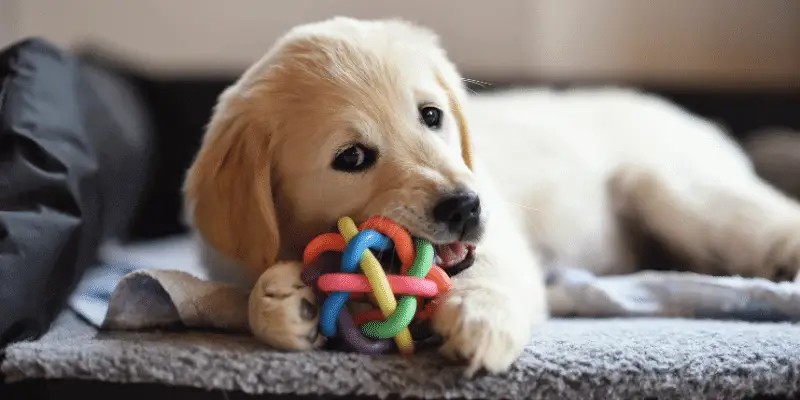
How to Check Your Dog’s Dental Care
Checking your dog’s teeth and mouth regularly is important as it will alert you to any issues, ensuring you can get them dealt with before they’re left to progress.
A few times a week, check for broken/wobbly teeth, swollen gums, plaque/tartar, lumps on the gums, and bleeding. Some of these signs are normal in puppies, but they can indicate a problem in adult dogs.
Should I Brush My Dog’s Teeth?
Keeping on top of your puppy’s dental hygiene is crucial as it helps prevent the build-up of plaque and tartar. Brushing your dog’s teeth from an early age will help them become accustomed to the routine, making the process go quicker and easier.
You’ll need a toothbrush, ideally, one with soft bristles like a baby toothbrush, and some toothpaste made especially for dogs. Never use human toothpaste as they often contain harmful ingredients for canines.
Around 8 to 16 weeks of age is the best time to start brushing your puppy’s teeth. They probably won’t find the experience too enjoyable (even adult dogs usually dislike it), so you might need to start slow by just getting them used to your finger being around their mouth.
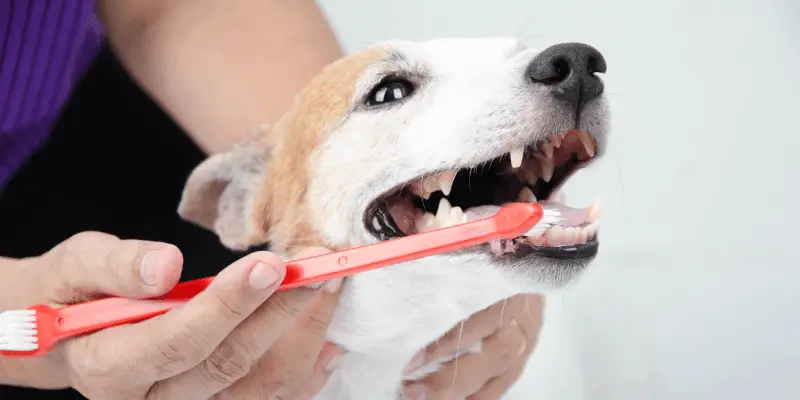
How to Keep Teeth Healthy
Just like humans, dogs require frequent dental care to keep those pearly whites clean and healthy.
Alongside brushing the teeth a few times a week, other ways to keep your puppy’s teeth healthy include dental chews, chew toys, frozen veggies (like carrots and celery), and regular oral checks at your vet.
How to Stop a Puppy from Nipping
It’s much easier to train your dog to stop biting when they are still young as once they’re mature, the behaviour will be instilled in them and harder to correct.
One of the most effective methods for stopping a biting puppy is to pay them no attention. If you yelp or flinch, your puppy will think you’re playing and might nip harder.
Instead, turn your face away from your puppy and tuck your arms and limbs in. You might need to stand up and step out of the room if your puppy is being particularly aggressive.
This should give your puppy the message that biting equals no playing or affection.
References
- https://vcahospitals.com/know-your-pet/teeth-teething-and-chewing-in-puppies
- https://www.akc.org/expert-advice/health/puppy-teething-and-nipping/
- https://www.akc.org/expert-advice/health/timeline-of-puppy-teething/
- https://caringheartsanimalhospital.com/puppy-teething-symptoms/
- https://www.rspca.org.uk/adviceandwelfare/pets/dogs/health/teeth
- https://www.akc.org/expert-advice/health/5-easy-ways-keep-dogs-teeth-clean/
- https://itsdogfood.com/blogs/news/3-foods-to-help-clean-your-dog-s-teeth-naturally

Written by: Joshua Gordon
Head of Research and Editorial, Joshua has over 7 years of experience as a finance and automotive research consultant. He is a childhood pet owner and dog enthusiast.

